Biography
Interests
Bruno Filipe Martel Monteiro1, Aljerry Dias do Rego1*, Angela Santana Teixeira2, Ulisses Almeida de Jesus2 & e Naiara Lorrani Silva de Lima2
1Resident Doctor in Obstetrics and Gynecology, Federal University of Amapá, Brazil
2Medicine Student, Federal University of Amapá, Brazil
*Correspondence to: Dr. Aljerry Dias do Rego, Obstetrician-Gynecologist doctor, Federal University of Amapá, Brazil.
Copyright © 2018 Dr. Aljerry Dias do Rego, et al. This is an open access article distributed under the Creative Commons Attribution License, which permits unrestricted use, distribution, and reproduction in any medium, provided the original work is properly cited.
Abstract
The Urinary incontinence (UI) is defined as the complaint of involuntary urine loss, a common clinical situation among women that can occur at any age group. The emergence UI has been associated with the practice of strenuous physical exercises. Among these activities there is the CrossFit. However, there are still few studies calculating the prevalence of urinary incontinence in the practitioners of this physical activity. In that way, this study is essential, since the UI considerably impairs the quality of life of the affected women. The purpose of this work was, through questionnaires, to estimate the prevalence of stress urinary incontinence (SUI) and determinate the epidemiological profile in CrossFit practitioners in the city of Macapá (state of Amapá, Brazil), apart from evaluate the impact on Quality of life of the women identified as incontinents through the application of the King’s Health Questionnaire. 40 women participated of this study, the average age was 29.12 years, with a BMI of 24.84 kg/m². All of them were at the reproductive years. Therefore, they weren’t in any hormonal replacement treatment, most of them were nulliparous or have a maximum of two children, they do not smoke and only two women reported chronic diseases. The prevalence of urinary incontinence during CrossFit was 12.5% and all incontinent women described, as the cause of SUI, the same exercises. The analysis of the quality of life has shown impairment at the performance of domestic tasks and physical/social limitations.
Abbreviations
ICS: International Continence Society
BMI: Body Mass Index
UI: Urinary Incontinence
SUI: Stress urinary incontinence
IUGA: International Urogynecological Association
KHQ: King’s Health Questionnaire
QOL: Quality of life
Introduction
The practice of physical exercises has become an increasingly habit among women [1]. Despite the proven
benefits of the quality of life (QOL) of those, some authors refer the excessive practice of physical activities
is a potential risk for the development of urinary incontinence [2]. Some studies have shown that the
symptoms of urinary loss are common among female athletes, with an incidence higher than 50% [3,4].
Urinary incontinence (UI) is defined, according to the International Continence Society (ICS) and the International Urogynecological Association (IUGA), as the complaint of involuntary loss of urine [5]. It represents a common problem between women, which may affect any age and compromise their quality of life [6], also being possibly related to cutaneous lesions such as ammoniacal dermatitis and urinary repeat infection [7].
Most of the affected women don’t seek for help, which may lead to an increased risk of urinary tract infection and incontinence associated with the dermatitis. UI is considered an important risk factor for mortality, institutionalization, hospitalization, falls, fractures and funcional decline [8].
CrossFit is defined as a set of constantly varied functional movements being performed in high intensity [9]. Some studies have related crossfit to stress urinary incontinence (IUE) [10]. At these studies, the women included in the research had no previous urinary incontinence and no risk factors that justified their emergence.
It is often neglected the presence of UI during physical activities, mainly by the lack of knowledge of the association between the two situations. Thus, it is also essential to know the possible risks in the practice of these activities, so the practitioner has the proper guidance in their realizations and then decide whether to continue them or not [7].
Materials and Methods
A cross-sectional observational study of quantitative analysis and data collection through interviews. The
inclusion criteria for these were: female gender; Age ≥ 18 years; CrossFit practitioners for a minimum
period of 1 year, and 3 hours per week. The exclusion criteria were: pregnant women; Minors under the age
of 18; Women with neurological or urological congenital diseases; Women carrying Urogenital fistulas or
with previous urinary incontinence; Puerperal women up to 6 months; Those with inability to communicate
and/or difficulty in answering the questionnaire.
The women were submitted to clinical interview with emphasis on epidemiological aspects and gynecological and obstetric antecedents (annex 1) and a specific questionnaire about urinary incontinence during CrossFit practice (Annex 2), comprehending CrossFit practice time, if there is any urinary loss during the activity and in which specific exercise.
Women with incontinence complaints were submitted to the King´s Health Questionnaire (KHQ) (annex 3) for quality of life assessment. The questionnaire consists of questions divided into domains that address health perception, impact of incontinence, limitations of task performance, physical and social limitations, personal relationship, emotions, sleep and energy, and Gravity measurements.
Due to this research is applied with human beings, it was necessary the use of recommendations described in resolution N°466/12 of the National Health Council, guaranteeing the confidentiality and anonymity of the subjects. The participants were informed about the research objectives and only included in this study by signing a free and informed term of consent. Authorization was obtained from the Federal University of Amapá through the coordination of medical residency for this research. The project was submitted from the post on the “Plataforma Brasil”, for analysis by the Ethics and Research Committee of the Federal University of Amapá.
The data were inserted into a spreadsheet in the Microsoft Excel ® editor and analyzed using the Software Statistical Package for the Social Sciences, version 22. Descriptive analyses were performed to verify the consistency of epidemiological data and obstetric and gynecological antecedents of women practicing CrossFit in the city of Macapá. The chi-square test was used to study the association between sports data and urinary incontinence of women practicing CrossFit in the city of Macapá. For all analyses, a significance level of < 5% was considered.
Results
The study included 40 women practicing CrossFit in the city of Macapá (state of Amapá, Brazil). The
prevalence of SUI during CrossFit practice was 12.5%, i. e., five women reported urine leakage in relation to
the activity (figure 1). Women identified as incontinents did not practice any other physical impact activity
and the majority (90%) performed CrossFit of 4-6 times per week (table 1).
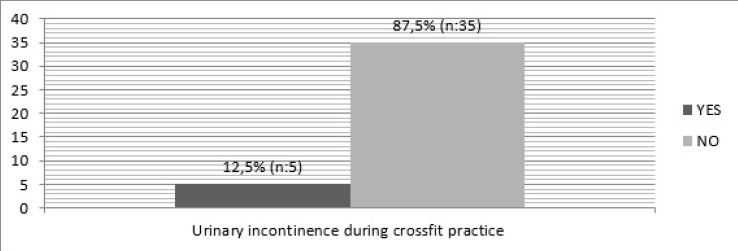
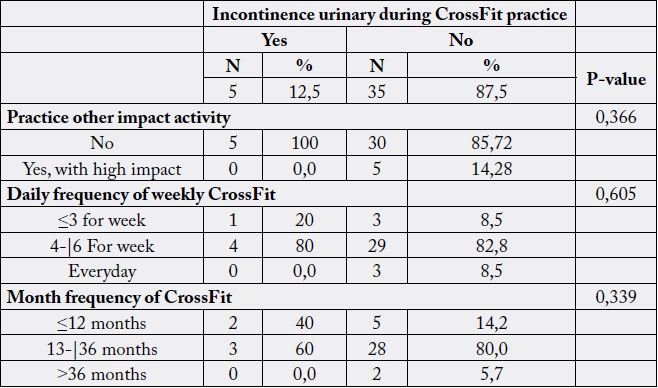
P-value: It was calculated based on the Test X² (Chi-square), for the significance level of 5%.
The analysis of the epidemiological and obstetric history of the sample is contained in table 2, where it is emphasized that no interviewees reported menopause (so, without the use of hormone replacement therapy). At this point, there was no statistically significant difference between the group with incontinence and what did not present (table 3). Regarding the presence of chronic diseases, two reported having hypothyroidism. The overall average age was 29.12 years, ranging between 19 and 48 years old. The mean weight was 62.6kg and the mean BMI was 24.84kg/m2 (table 2).
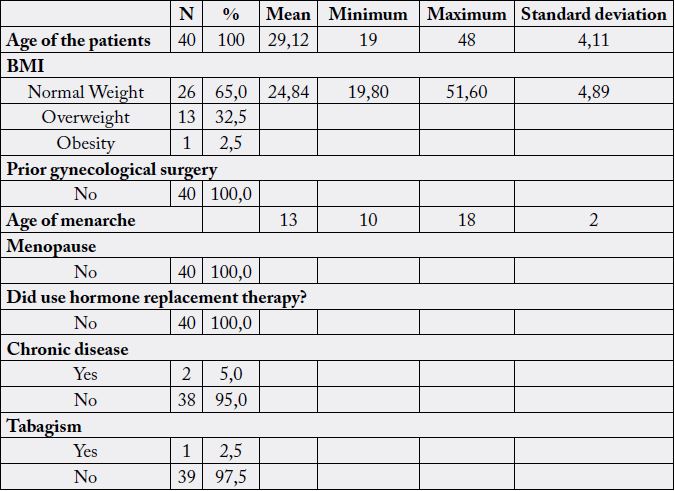
P-value : It was calculated based on the Test X² (Chi-square), for the level of significance of 5%
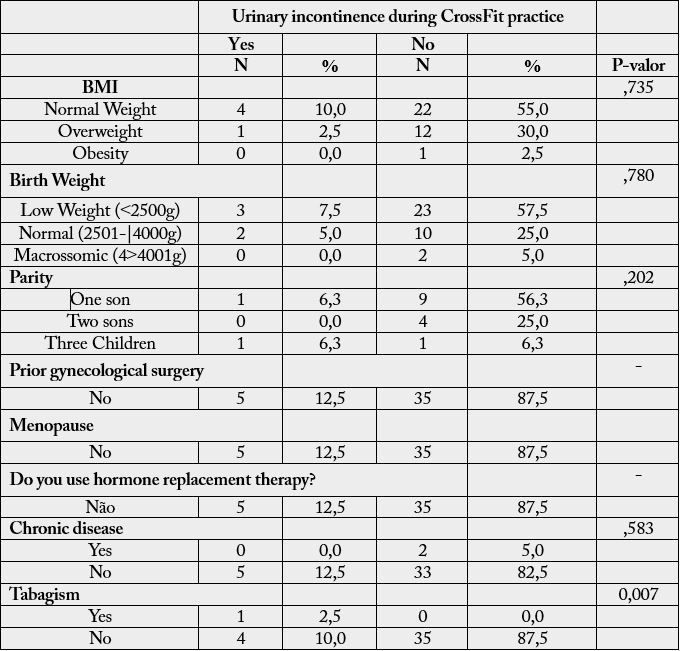
Among the women studied, 60% were nulliparous (24 women), 35% of them had no more than two births (non multiparous) and 5% multiparous (3 or more deliveries) (figure 2). Cesarean delivery was prevalent in the sample studied, representing more than half of all deliveries described (54.1%) (figure 3). Between the women who had children, 10% of them were macrossomic, that is, they were 4 kg or more at birth.


Women identified as incontinent had a mean age of 29.2 years, BMI of 22.6 kg/m2, none had previous gynecological surgery and, at least, they practiced CrossFit activity three times a week for 1 hours daily (table 4). Among thirteen exercises analyzed, four were cited as inducers of urinary loss by all incontinents, according to figure 4.
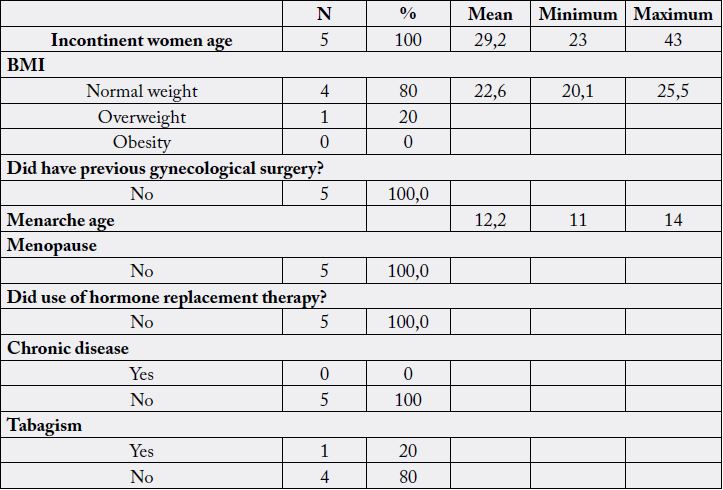
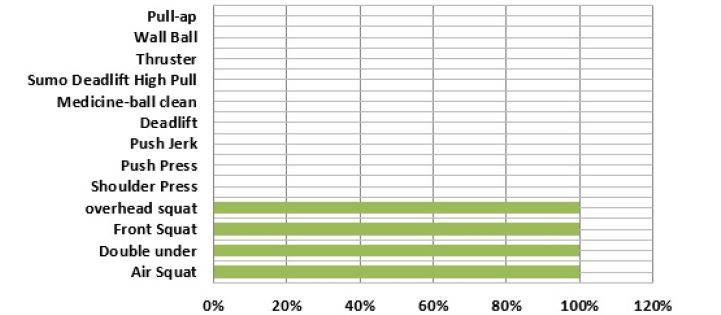
The women studied, mostly (90%), practiced CrossFit at least three times a week, the average daily minutes of physical activity were 72 minutes, and only 12.5% of women practiced other physical impact activity (table 5), being Related activities: Futsal, bodybuilding and jiu-jitsu.
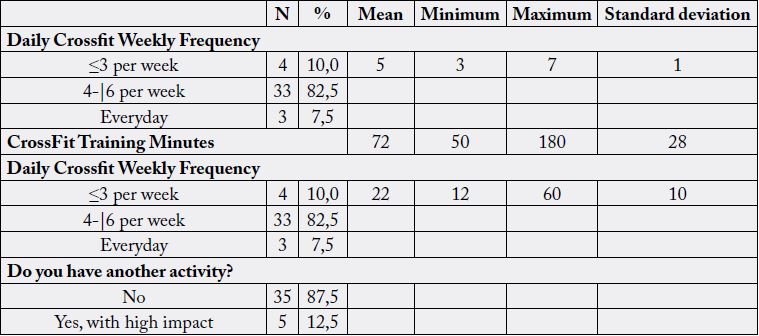
The analysis of quality of life, through the King’s Health Questionnaire (KHQ), revealed that they all classify their health as good, showing that only one participant had an important limitation in the performance of domestic tasks. Among the incontinents, 20% described physical/social limitation, with impairment in physical activities besides CrossFit, such as walking and running. The others KHQ domains were not described as affected (table 6).
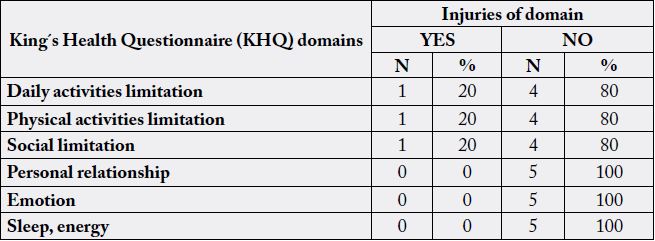
Discussions
The occurrence of urinary incontinence during the practice of physical exercises, especially of high impact,
as CrossFit, can be explained due to the higher intra-abdominal pressure they generate, overloading the
musculature of the pelvic floor [11]. In this sense, the exercise is a risk factor for the incidence of urinary
dysfunctions such as IUE [2]. It is possible that during high-impact sports, intra-abdominal pressure is
raised enough to allow intravesical pressure to exceed intra-urethral pressure. This excessive rise can oppress
even the normal mechanism of continence, favoring the emergence of urinary incontinence in athletes [12].
A study evaluating the presence of SUI in 27 CrossFit practitioners between 18 and 45 years of age in Paraná found a prevalence of 7.4% [13]. Studies conducted with other physical activities also identified SUI: a study with 23 volleyball players in the state of Rio Grande do Sul (Brazil) found 7 (30.4.%) incontinents women [14]. Another study, in 2012, identified 37.5% of SUI in a sample of practitioners of “Jump” [15].
Physical activity can “reveal” urinary incontinence, which is only perceived by performing physical activities that predispose to the urine loss, even in women who do not have risk factors such as age and parity.
The specific analysis of which CrossFit exercises led to urine loss showed that all the women identified as incontinents presented the incontinence in four exercises: overhead squat, front squat, double under and air squat. The overhead squat and front squat are types of squats with overloading; Air squat is a load-free squat and the double under is an exercise with rope jumps. This impact caused by squats can affect the continence mechanism by altering the amount of force transmitted to the pelvic floor. Jumps, in turn, enable the contact of the feet with the soil and can generate a maximum reaction force that increases by 16 times the weight corporal [16]. The force of transmission of the shock, which occurs between the feet and the ground and that is transferred to the pelvic floor, can contribute to the incontinence among nulliparous young women and practitioners of sports that demand high impact [16,17].
The women interviewed constituted a relatively homogeneous group, being mostly young (60% were less than thirty years), non-smokers (97.5%), with BMI in the normal range (65%), nulliparous (60%), without chronic diseases (95%), without previous gynaecological surgeries and all had no prior urinary incontinence, therefore, without known risk factors for stress urinary incontinence. The understanding of the existence of risk factors for SUI is fundamental to infer whether they are preponderant or not for the onset or worsening of the disease.
The analysis of quality of life showed that although the interviewees classified their health as good, there was a loss in the performance of domestic activities and a certain physical or social limitation in activities such as walking or running.
UI involves several negative aspects related to the QOL of women. These include restrictions regarding social and sexual relations, psycho-emotional changes and decreased sleep/rest quality [18,19].
Most of the physical activities do not involve voluntary contraction of these muscles during exercises that increase intra-abdominal pressure. In this way, women who exercise don’t have the perineal muscles stronger than those who don’t exercise. It is imperative that practitioners of physical activities, especially those ones that demand high impact, be taught to perform a pre-contraction or simultaneous contraction of this musculature during the performance of CrossFit exercises, preventing the urinary incontinence onset or worsening, and improving the bladder control [20].
Supplementary Files (if applicable)
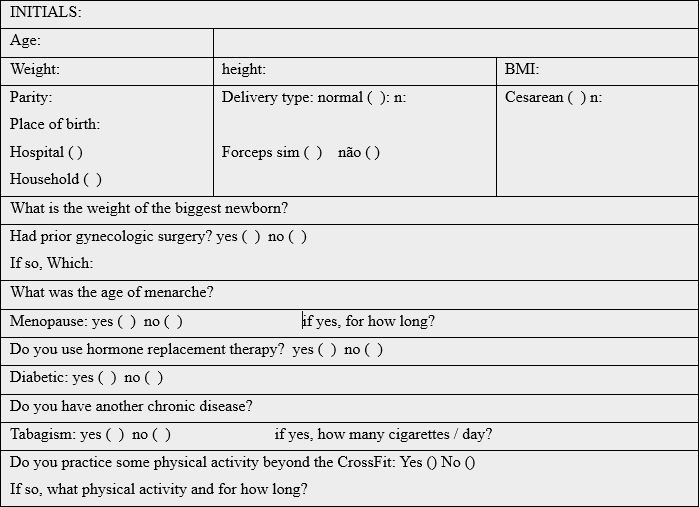
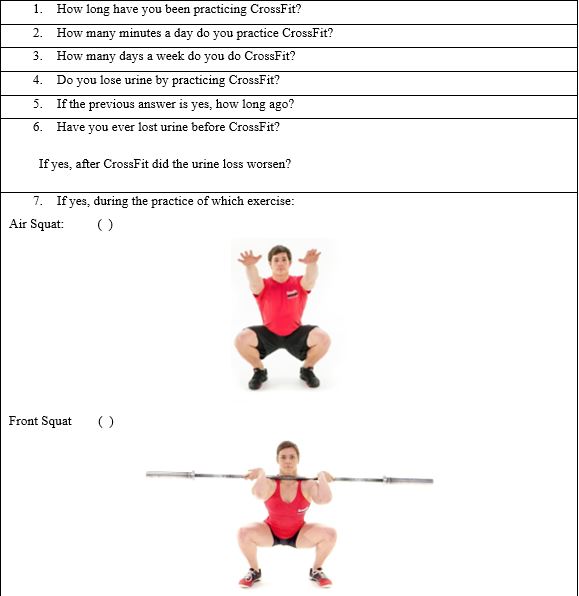
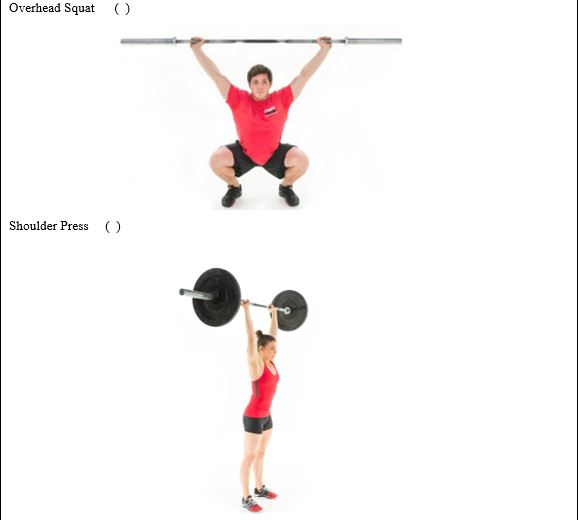
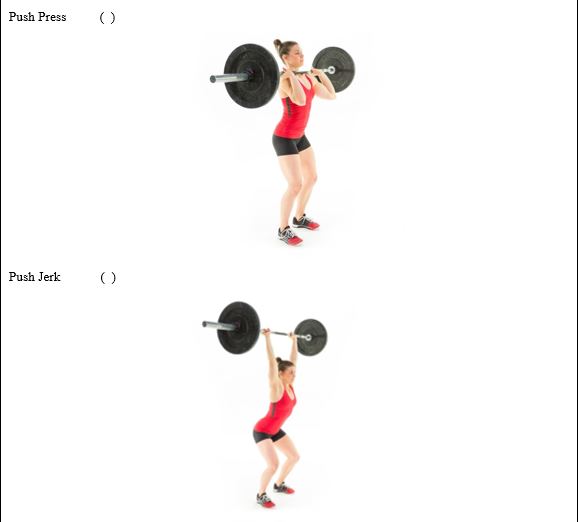
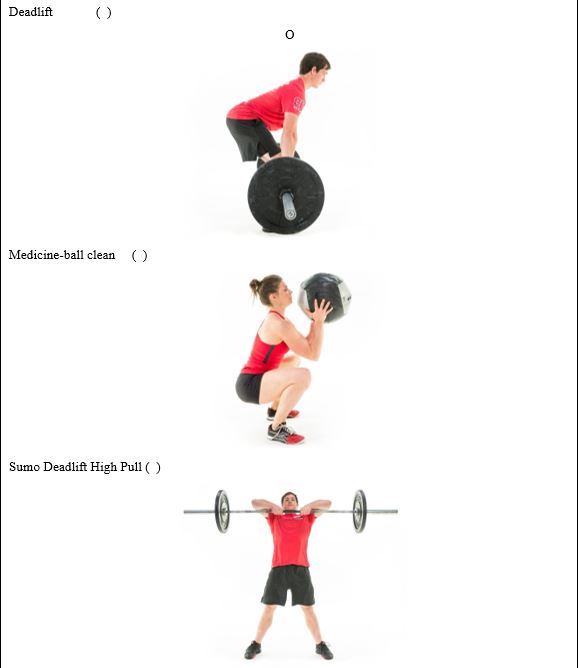
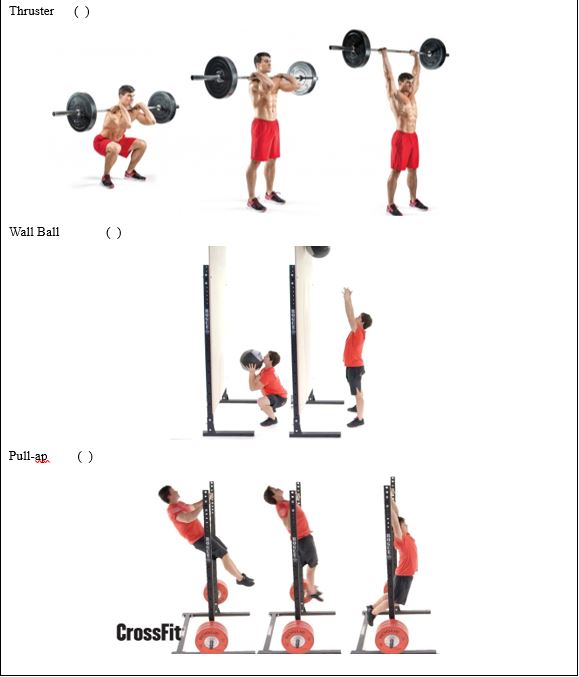
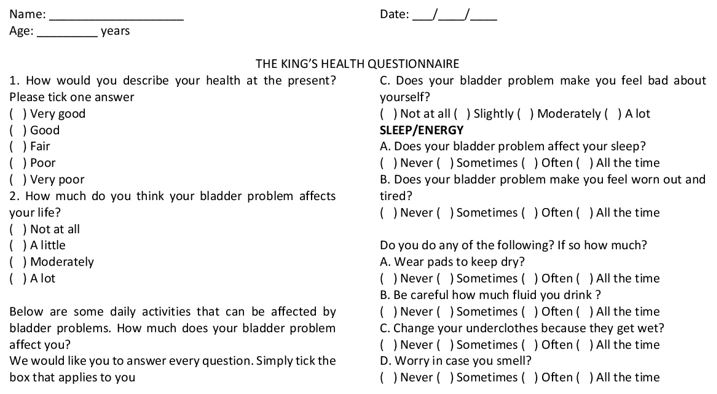
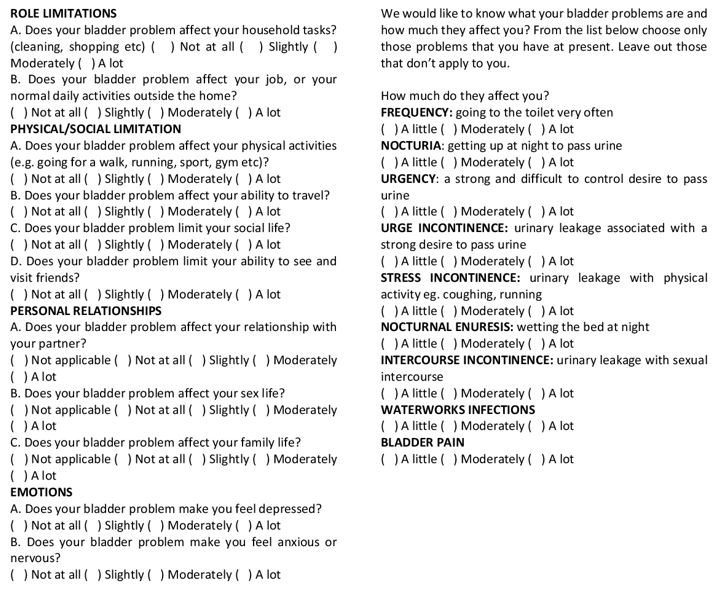
Conclusions
As noted in this study, the prevalence of SUI in women practicing CrossFit in the city of Macapá was 12.5%. Most of them were young, non-smokers, lean, nulliparous, without chronic diseases and without urinary incontinence prior to CrossFit practice. In this case, we can infer that CrossFit activity may have been preponderant for the emergence of stress urinary incontinence.
The exercises related to the presence of urinary incontinence were four: overhead squat, front squat, double under and air squat.
The women who was identified SUI classified their health as good when they responded to the King´s Health Questionnaire, however, they described impairment in the performance of domestic tasks and physical/ social limitation. Despite, no participant in the study reported impairment during sexual intercourse.
Conflicts of Interests
The article should be free from any such conflicts between authors or with others in any aspect.
Bibliography

Hi!
We're here to answer your questions!
Send us a message via Whatsapp, and we'll reply the moment we're available!